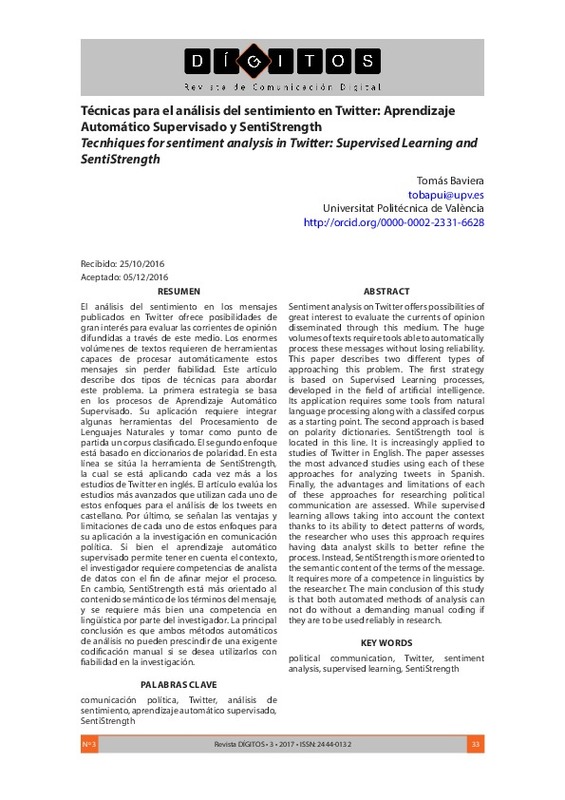JavaScript is disabled for your browser. Some features of this site may not work without it.
Buscar en RiuNet
Listar
Mi cuenta
Estadísticas
Ayuda RiuNet
Admin. UPV
Técnicas para el análisis del sentimiento en Twitter: Aprendizaje Automático Supervisado y SentiStrength
Mostrar el registro sencillo del ítem
Ficheros en el ítem
| dc.contributor.author | Baviera, Tomás
|
es_ES |
| dc.date.accessioned | 2020-10-27T04:32:17Z | |
| dc.date.available | 2020-10-27T04:32:17Z | |
| dc.date.issued | 2017 | es_ES |
| dc.identifier.uri | http://hdl.handle.net/10251/153230 | |
| dc.description.abstract | [EN] Sentiment analysis on Twitter offers possibilities of great interest to evaluate the currents of opinion disseminated through this medium. The huge volumes of texts require tools able to automatically process these messages without losing reliability. This paper describes two different types of approaching this problem. The first strategy is based on Supervised Learning processes, developed in the field of artificial intelligence. Its application requires some tools from natural language processing along with a classifed corpus as a starting point. The second approach is based on polarity dictionaries. SentiStrength tool is located in this line. It is increasingly applied to studies of Twitter in English. The paper assesses the most advanced studies using each of these approaches for analyzing tweets in Spanish. Finally, the advantages and limitations of each of these approaches for researching political communication are assessed. While supervised learning allows taking into account the context thanks to its ability to detect patterns of words, the researcher who uses this approach requires having data analyst skills to better refine the process. Instead, SentiStrength is more oriented to the semantic content of the terms of the message. It requires more of a competence in linguistics by the researcher. The main conclusion of this study is that both automated methods of analysis can not do without a demanding manual coding if they are to be used reliably in research. | es_ES |
| dc.description.abstract | [ES] El análisis del sentimiento en los mensajes publicados en Twitter ofrece posibilidades de gran interés para evaluar las corrientes de opinión difundidas a través de este medio. Los enormes volúmenes de textos requieren de herramientas capaces de procesar automáticamente estos mensajes sin perder fiabilidad. Este artículo describe dos tipos de técnicas para abordar este problema. La primera estrategia se basa en los procesos de Aprendizaje Automático Supervisado. Su aplicación requiere integrar algunas herramientas del Procesamiento de Lenguajes Naturales y tomar como punto de partida un corpus clasifcado. El segundo enfoque está basado en diccionarios de polaridad. En esta línea se sitúa la herramienta de SentiStrength, la cual se está aplicando cada vez más a los estudios de Twitter en inglés. El artículo evalúa los estudios más avanzados que utilizan cada uno de estos enfoques para el análisis de los tweets en castellano. Por último, se señalan las ventajas y limitaciones de cada uno de estos enfoques para su aplicación a la investigación en comunicación política. Si bien el aprendizaje automático supervisado permite tener en cuenta el contexto, el investigador requiere competencias de analista de datos con el fin de afinar mejor el proceso. En cambio, SentiStrength está más orientado al contenido semántico de los términos del mensaje, y se requiere más bien una competencia en lingüística por parte del investigador. La principal conclusión es que ambos métodos automáticos de análisis no pueden prescindir de una exigente codificación manual si se desea utilizarlos con fiabilidad en la investigación. | es_ES |
| dc.description.sponsorship | Este trabajo ha sido posible gracias a Emilio Giner Hernández por introducir al autor en el análisis automatizado de sentimiento, y a Lorena Cano Orón por sugerir redactarlo. La presente investigación forma parte del proyecto I+D Los flujos de comunicación en los procesos de movilización política: medios, blogs y líderes de opinión financiado por el Ministerio de Economía y Competitividad (referencia CSO2013-43960-R). | es_ES |
| dc.language | Español | es_ES |
| dc.publisher | Universitat de Valencia | es_ES |
| dc.relation.ispartof | Dígitos | es_ES |
| dc.rights | Reconocimiento (by) | es_ES |
| dc.subject | Comunicación política | es_ES |
| dc.subject | es_ES | |
| dc.subject | Análisis de sentimiento | es_ES |
| dc.subject | Aprendizaje automático supervisado | es_ES |
| dc.subject | SentiStrength | es_ES |
| dc.subject | Political communication | es_ES |
| dc.subject | Sentiment analysis | es_ES |
| dc.subject | Supervised learning | es_ES |
| dc.subject.classification | COMERCIALIZACION E INVESTIGACION DE MERCADOS | es_ES |
| dc.title | Técnicas para el análisis del sentimiento en Twitter: Aprendizaje Automático Supervisado y SentiStrength | es_ES |
| dc.title.alternative | Tecnhiques for sentiment analysis in Twitter: Supervised Learning and SentiStrength | es_ES |
| dc.type | Artículo | es_ES |
| dc.identifier.doi | 10.7203/rd.v1i3.74 | es_ES |
| dc.relation.projectID | info:eu-repo/grantAgreement/MINECO//CSO2013-43960-R/ES/LOS FLUJOS DE COMUNICACION EN LOS PROCESOS DE MOVILIZACION POLITICA: MEDIOS, BLOGS Y LIDERES DE OPINION/ | es_ES |
| dc.rights.accessRights | Abierto | es_ES |
| dc.contributor.affiliation | Universitat Politècnica de València. Departamento de Economía y Ciencias Sociales - Departament d'Economia i Ciències Socials | es_ES |
| dc.description.bibliographicCitation | Baviera, T. (2017). Técnicas para el análisis del sentimiento en Twitter: Aprendizaje Automático Supervisado y SentiStrength. Dígitos. 1(3):33-50. https://doi.org/10.7203/rd.v1i3.74 | es_ES |
| dc.description.accrualMethod | S | es_ES |
| dc.relation.publisherversion | https://doi.org/10.7203/rd.v1i3.74 | es_ES |
| dc.description.upvformatpinicio | 33 | es_ES |
| dc.description.upvformatpfin | 50 | es_ES |
| dc.type.version | info:eu-repo/semantics/publishedVersion | es_ES |
| dc.description.volume | 1 | es_ES |
| dc.description.issue | 3 | es_ES |
| dc.identifier.eissn | 2444-0132 | es_ES |
| dc.relation.pasarela | S\357309 | es_ES |
| dc.contributor.funder | Ministerio de Economía y Competitividad | es_ES |








